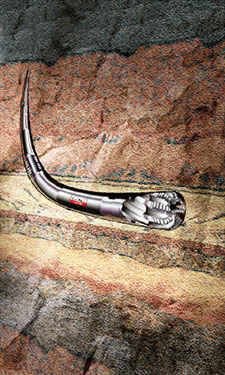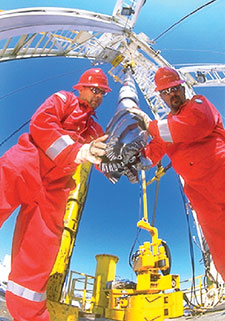Drilling Report
Slimhole rotary steerable system field trials yield record performance
Third-generation bit guiding system shows impressive application capability in drilling 7,145 ft in a 6-3/4-in. horizontal production zone.
Blaine Comeaux, Sperry Drilling Services (Halliburton)
In recently completed field trials, a new slimhole point-the-bit rotary steerable system set a world record for the longest run drilled with a rotary steerable system in a 6-3/4-in. hole, drilling the entire 7,145-ft horizontal section of one Alaskan well in a single run of 61.5 hr. In a second well in Canada, the system was geosteered to directionally drill 2,445 ft, completing the entire 6-1/8-in. hole section in 51 drilling hours.
With successful field trials complete, the third-generation drilling system provides a new rotary steerable option for use in slimhole applications from 6 to 6-3/4 in. Part of the FullDrift drilling suite from Sperry Drilling Services, a Halliburton company, the Geo-Pilot 5200 Series system offers a slimhole solution for the growing re-entry drilling market in mature fields, allowing for significantly extended horizontal production sections and enabling small targets to be reached from existing structures. The following discussion describes the new system and its successful applications in Alaska and Canada.
HOW THE SYSTEM WORKS
The new slimhole system retains many of the main benefits of the second-generation, point-the-bit drilling system, which deflects the bit by flexing an internal rotating driveshaft between two bearings, allowing the wellbore to be steered in any desired direction while rotating the drillstring.
Designed for use with Security DBS FullDrift extended gauge PDC or roller cone bits, the Geo-Pilot system uses the extended-gauge bit as the near-bit stabilizer. As a result, other than the bit itself and the short reference stabilizer about 5 m above the bit, no part of the rotary steerable tool housing contacts the wellbore at any time, greatly reducing the possibility of differential sticking. Instead, the bit is pointed in the direction that it needs to drill and the bit face remains centered to efficiently drill the formation, Fig. 1.
 |
Fig. 1. Schematic of rotary steerable system guiding drilling of a slimhole horizontal lateral borehole.
|
|
Because the extended-bit gauge acts as a stabilizer or centralizer, the bit cutting structure is protected, keeping it sharper longer to provide higher overall ROP. This, in turn, maintains the smooth and balanced cutting action of the bit as it was originally designed. The stabilizing effect has multiple additional benefits, such as significantly lower vibration and superior hole quality. The system eliminates hole spiraling, increases daily footage and improves directional control. Drilling performance is increased and typical “non-constructive” bit behavior – such as sidecutting, whirl and stick slip – is either minimized or eliminated.
The slimhole version provides the same precision, speed and borehole quality as larger size systems, as shown in Fig. 2, but in a shorter package that yields higher dogleg capability. With a specified build rate of 10°/100 ft and a maximum observed build rate of 16°/100 ft, the new slimhole system is suitable for drilling exits out of existing casing strings for redevelopment drilling. It also provides significant reductions in torque and drag by allowing 100% drillstring rotation, so horizontal section length can be extended beyond the reach of a conventional steerable system. Hole cleaning efficiency also is improved due to the continuous agitation of cuttings.
 |
Fig. 2. The new slimhole rotary steerable system being run into the wellbore.
|
|
In addition, because of its point-the-bit concept, the slimhole system can sidetrack horizontally from a horizontal motherbore, to create a “crow’s foot” pattern in the reservoir for maximum exposure.
The system is virtually invisible to the drilling operation, providing on-bottom control via the Geo-Span downlink system. The system has consistently demonstrated a 2 to 3-hr savings per day by eliminating drilling interruptions typically required for downlinking with other rotary steerable systems. The send-and-receive downlink cycle is completed in about 90 sec while drilling ahead, with no interruption in LWD telemetry and no changes in pump or rotary speeds. Also, the new deflection technique used in the slimhole version is faster than previous versions.
CANADA AND ALASKA
The Geo-Pilot 5200 Series system completed initial field testing for an operator in Canada by drilling the entire 6-1/8-in. section of 2,445 ft in 51 drilling hours. The system performed flawlessly over a wide range of deflection settings. Even though the well profile was completely horizontal, the customer permitted some testing, during which, the slimhole system demonstrated a dogleg of 7.3°/100 ft at a partially deflected setting.
Using rotary steerable technology vs. a conventional mud motor in the slimhole section of this well allowed the customer to eliminate the additional trip and rig time required to rearrange heavy-weight pipe, as is common in conventionally drilled horizontal wells. The rotary steerable system also eliminated the need for lubricity beads, which were required for friction reduction on previous wells.
The slimhole rotary steerable system was used in the Alaskan application to maximize production from the horizontal reservoir interval. The system had to survive drilling over 50 concretions, or boulders, which typically caused the ROP to slow to 1 to 2 m/hr. Even under these tough drilling periods, the system saw no performance degradation.
The well was carefully steered based on real-time formation evaluation data, with numerous changes in trajectory required to accurately position the well in the reservoir. Using the Geo-Span downlink service, the Geo-Pilot 5200 Series system was steered “on-the-fly,” with zero interruptions for downlinking, providing the geologist with complete control over wellbore trajectory while achieving maximum ROP and daily footage.
The new slimhole, point-the-bit rotary steerable system provides the necessary technology to redevelop assets in maturing basins worldwide, extending the reach capability from existing structures and making marginal redevelopment projects more economically feasible. By improving drilling efficiency and reducing non-productive time through elimination of downlink interruptions, proper bit stabilization and superior hole quality, the system is expected to significantly reduce the cost of redeveloping existing fields. 
THE AUTHOR
|
| |
Blaine Comeaux is the Global Product Champion, Geo-Pilot rotary steerable system, for Halliburton’s Sperry Drilling Services product service line. He earned a BS degree in petroleum engineering from Louisiana State University in 1984. He has been with Sperry for 20 years and a product champion for the last six years. He has worked in various positions from field engineer to technical support and strategic planning.
|
| |
|
|




